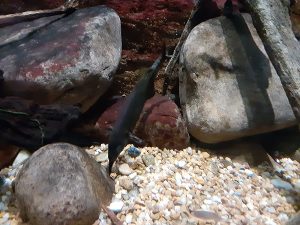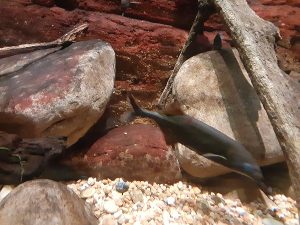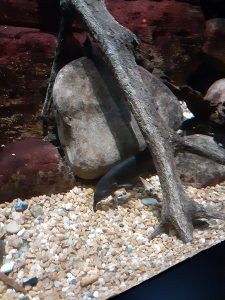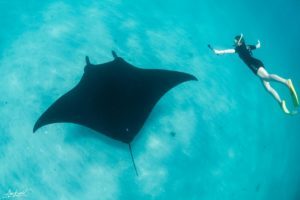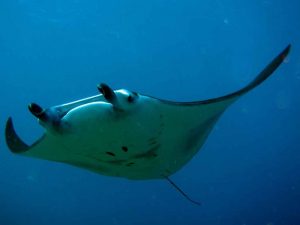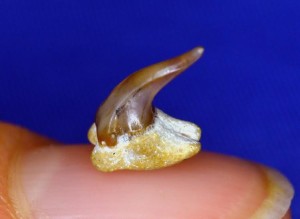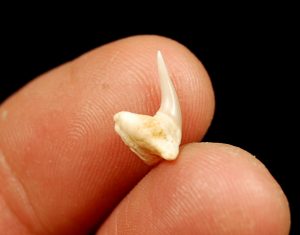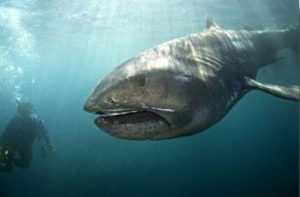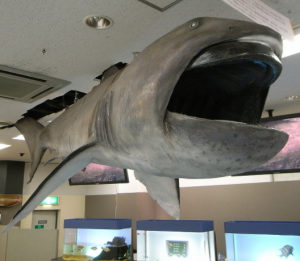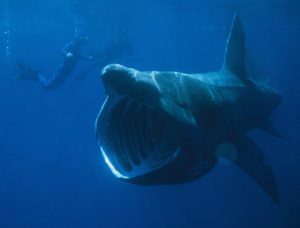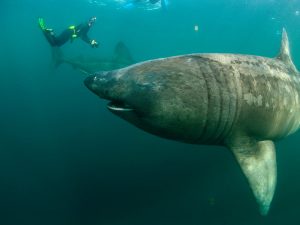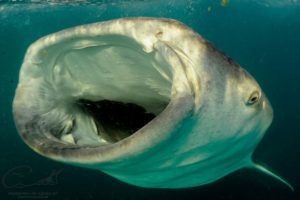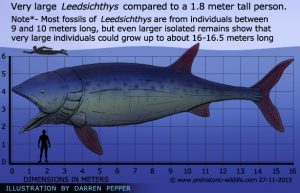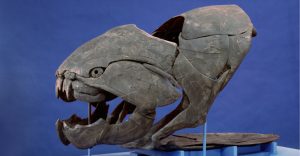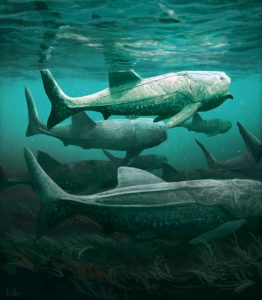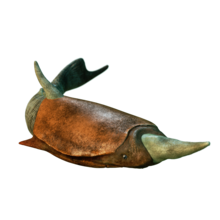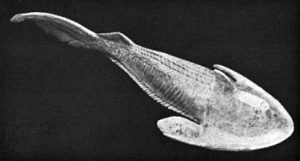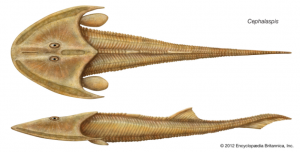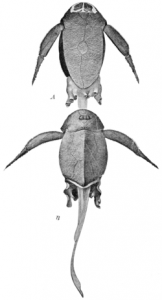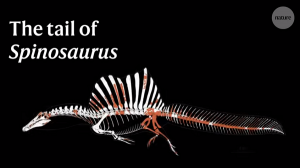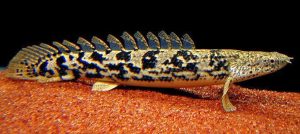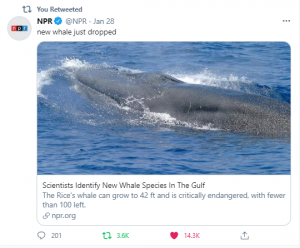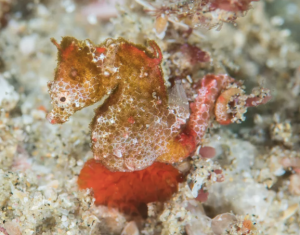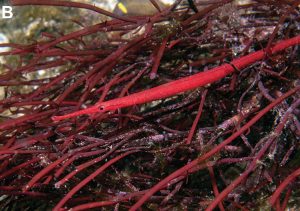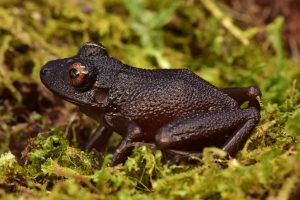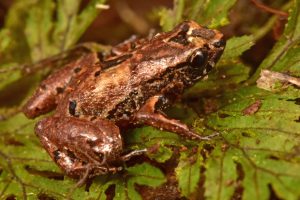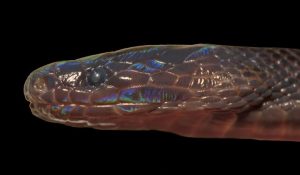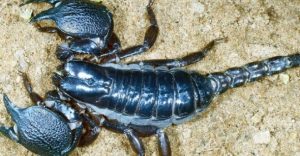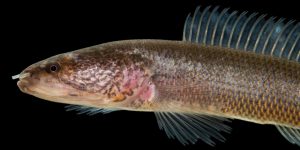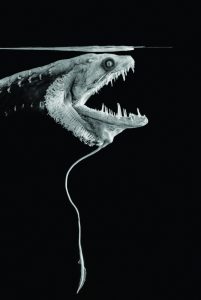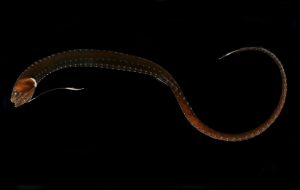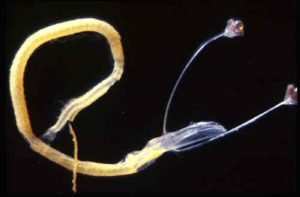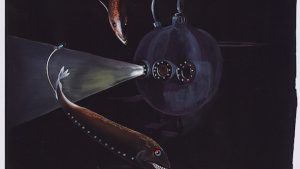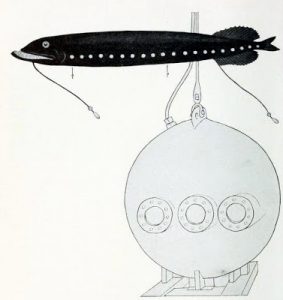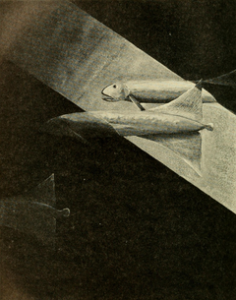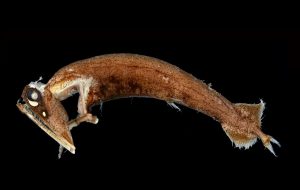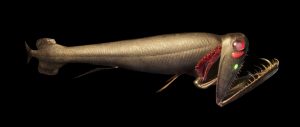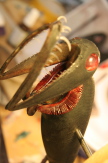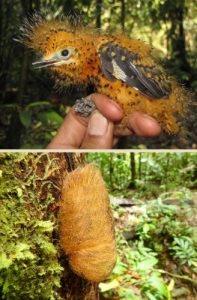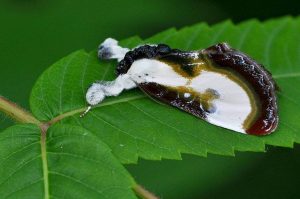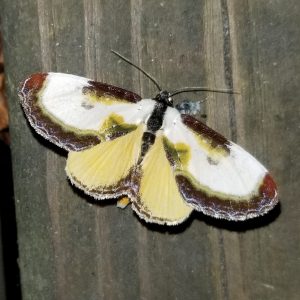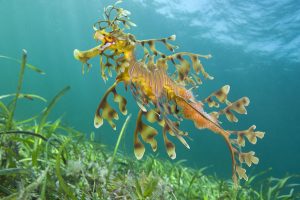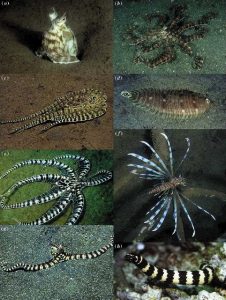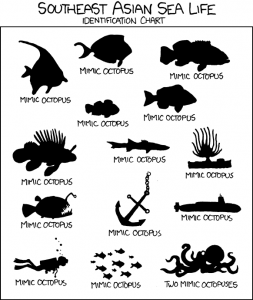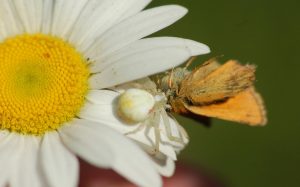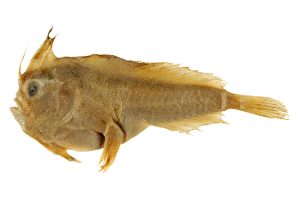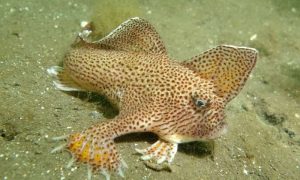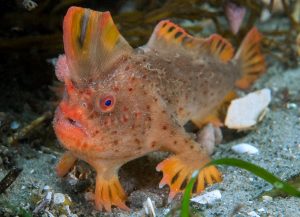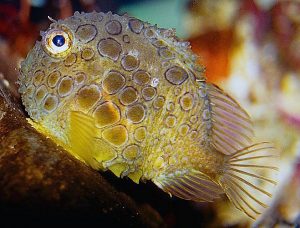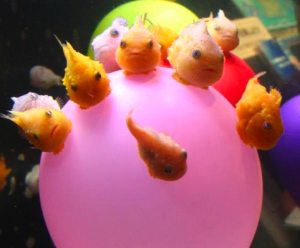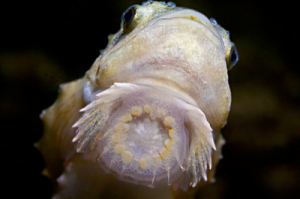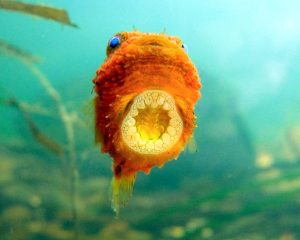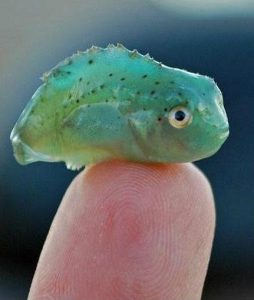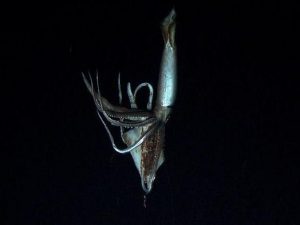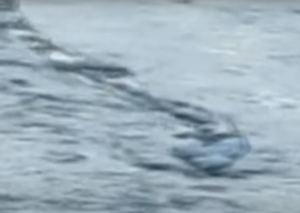Podcast: Play in new window | Download (Duration: 17:28 — 18.2MB)
Sign up for our mailing list! We also have merch!
Let’s learn about some strange fish of the mesopelagic, or the twilight zone deep in the ocean! Thanks to Page, Joel, Anonymous Animal Lover, Brigham, and Fireburster for suggestions this week!
Further reading:
Further viewing:
Pacific viperfish (video embedded)
The Pacific viperfish, head-on (or rather teeth-on), still from video linked above:
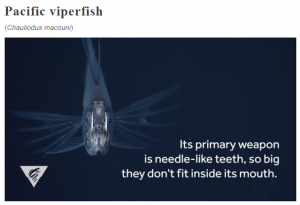
Sloane’s viperfish, rocking those teeth:
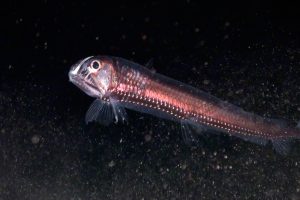
The blobfish as it’s usually seen on the internet:
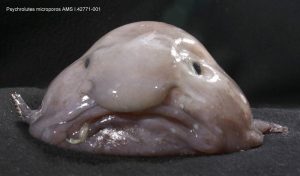
The blobfish as it looks when it’s cozy in its deep-sea environment:
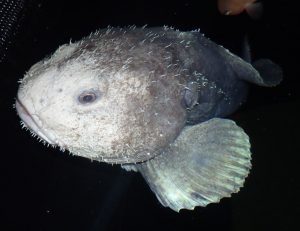
The barreleye, which I have helpfully labeled for you:
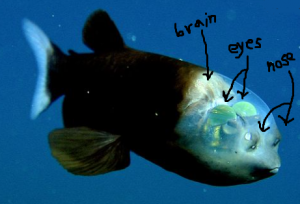
Look at the bristlemouth’s sharp thin teeth! Good thing it’s only a few inches long:
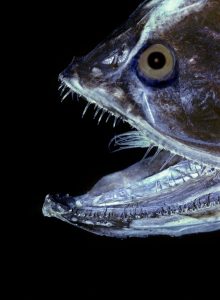
An indignant bristlemouth (someone should take MS Paint away from me):
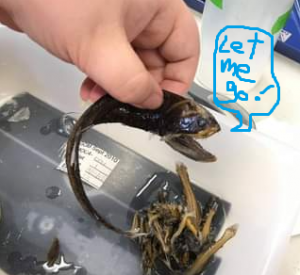
The bristlemouth is the most abundant vertebrate in the WORLD (photo by Paul Caiger):
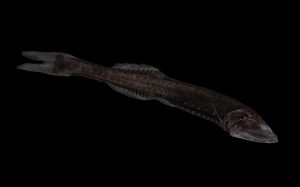
Show transcript:
Welcome to Strange Animals Podcast. I’m your host, Kate Shaw.
Where on earth does the time go? Suddenly we’re halfway through 2021 and I’m still vaguely thinking we’re only a few months in. I’m getting seriously behind on listener suggestions, so let’s have an episode about some weird fish that’s all listener suggestions. Thanks to Page, Joel, an animal lover who wants to remain anonymous, Brigham (whose name I hope I’m pronouncing correctly), and someone who calls themself Fireburster. Fireburster and Anonymous Animal Lover also both left us really nice reviews, so thank you! I picked all these suggestions at random, just grabbing fish suggestions that sounded interesting, but the great thing is they all turned out to live in a specific part of the deep sea.
Brigham and Fireburster both suggested the same fish, so let’s start with that one: the dragon fish. Neither of them specified which kind of dragon fish they’re talking about, though. It’s a popular name for weird fish of various kinds. We’ve even talked about a few before, the Pacific blackdragon of episode 193, which was coincidentally suggested by Page, and the barbeled dragonfish in that same episode. That’s the episode about William Beebe’s mystery fish, which happens to be my current favorite.
We only talked about the barbeled dragonfish briefly before, so let’s learn more about them now.
The barbeled dragonfish gets its name from the filament that hangs down from its chin, called a barbel. If you’ve ever wondered what the proper name for a catfish’s whiskers is, they’re also barbels. The dragonfish’s barbel has a photophore at the end that produces blue-green bioluminescent light, and the fish flashes the light to attract prey. Its head is large and its jaws are full of sharp teeth, so when an animal comes close, CHOMP! The barbeled dragonfish grabs it.
The dragonfish isn’t very big, with the blackdragon that we talked about in episode 193 being the largest at only 16 inches long, or 40 cm. Most species are about half that. So what happens when an animal the same size as or even bigger than the dragonfish happens along?
The dragonfish eats it, that’s what happens. It has large jaws that it can unhinge to swallow prey that’s bigger than it is, and its stomach can expand considerably to hold whatever it swallows. Mostly it just eats tiny animals like krill and amphipods, though.
We don’t know a whole lot about dragonfish. Various species live throughout most of the world’s oceans, especially in tropical and subtropical areas, and they don’t live in the deepest parts of the ocean. Instead, they’re found in what’s called the twilight zone, or more properly the mesopelagic. Only 1% of all light shining down from the surface makes it down this far, which is why so many animals produce their own bioluminescent light. The dragonfish also has photophores along its sides that it can flash to help attract prey or attract mates. On nights when the moon isn’t too bright, the dragonfish will migrate closer to the surface to find more food, but it makes sure to go back to the twilight zone before the sun rises.
[twilight zone music]
One genus of dragonfish is called the viperfish, and they’re a little different from other dragonfish. Instead of a barbel on the chin, viperfish have a light at the end of a long spine that’s a modified dorsal fin. This is similar to the anglerfish we’ve talked about many times before, even though dragonfish and anglerfish aren’t related. Convergent evolution, at it again!
The viperfish has teeth so long they don’t fit in its mouth. Instead, they stick out, which gives it its other name of fangfish. Sloane’s viperfish has the largest teeth of all the viperfish species, so long that they form a cage across its mouth to stop prey from escaping before the fish can swallow it. Unlike most dragonfish, Sloane’s viperfish sometimes swims toward its prey very quickly, slamming into it and wounding it with its fangs. It even has a sort of built-in shock absorber in its spine right behind its head. The Pacific viperfish can also be aggressive when hunting.
This is probably a good place to learn a little more about the twilight zone, AKA the mesopelagic. It’s measured not by depth but by how much light is available from the surface, in this case only 1% of light. There’s also not as much oxygen in the water here as at the surface. Many, if not most, animals that live in the mesopelagic migrate closer to the surface at night to find food, then retreat to the darkness below to avoid being seen as the sun rises and fills the upper layers of water with more light.
Lots and lots of animals live in the mesopelagic, from giant squid to oarfish, although most of the animals here are small. Below this layer of water is the bathypelagic, and below that is the real depths, the abyssopelagic where conditions are extreme and life gets really weird and scarce. The uppermost layer of the ocean is called epipelagic, if you were wondering. No plants live in the mesopelagic or below, because there’s not enough light. Obviously, the ocean isn’t always deep enough to have a bathypelagic layer or below, and quite often the mesopelagic ends at the sea floor.
It’s hard to study mesopelagic animals because many of them can’t survive at the surface. They’re built to withstand the increased water pressure at depths up to 3,300 feet, or 1000 meters, below the surface, and when they’re dragged up in nets they often die within minutes. Many marine animals have an organ called a swim bladder that’s filled with gases, which helps the animal stay neutrally buoyant in the water so it doesn’t float upward or sink downward when it’s not moving. The animal can adjust the amount of gas in its bladder as it swims upward, but when it’s pulled upward quickly in a net it can’t expel enough gas fast enough and the swim bladder can burst or expand so much that it squishes the rest of its insides, killing the animal before it even reaches the surface. Animals that don’t migrate vertically often don’t have a swim bladder since they don’t need it, and they’re just adapted for water pressure that’s as much as 120 times greater than pressure at the surface. This pressure difference is why blobfish look so blobby, so let’s talk about the blobfish next, Anonymous’s suggestion.
The blobfish lives on the sea floor in deep water near Australia and New Zealand. It grows about a foot long at most, or 30 cm, and is grayish with little spikes all over it. It has a gelatinous body with weak muscles and a weak skeleton, but it doesn’t need either since the intense pressure of the water presses in around the fish all the time and keeps it just the way it should be. It looks like a fish. Its gelatinous flesh is slightly less dense than the water around it, which means it can float just above the sea floor without much effort, just drifting along, giving its tail and broad fins a little flap every so often. It eats whatever detritus floats down from far above, although it’s also mostly on the lookout for small crustaceans that live on the sea floor.
The problem comes when a fishing net catches a blobfish and brings it to the surface. Suddenly there’s no nice firm water around the fish. Instead of being slightly less dense than the water around it, the blobfish is suddenly way more dense than the water, and it expands as a result. Then someone looks at this horrible dead pinkish blob that was once a happy live fish and thinks, “Gross! I’ll take a picture of that for the internet,” and that’s why the blobfish gets its name. Poor blobfish!
Fortunately, scientists have developed a compression chamber for the animals they study. When a deep-sea animal is put in the compression chamber and brought to the surface, the compression chamber keeps the water pressure where the animal needs it. The animal doesn’t die horribly, and that allows researchers to observe a live animal instead of a dead blobby one.
Next, let’s learn about Page’s suggestion, the barreleye fish. It lives in the North Pacific in deep water, and it has upward-pointing eyes that are very sensitive to light. It’s a small fish, only about six inches long, or 15 cm, and is mostly dark in color, as you would expect from a deep-sea fish. It’s chonky in shape with large fins that help it stay motionless in the water while it looks for tiny fish and jellyfish silhouetted against the water’s surface far above. Then the barreleye will move quickly to grab its prey.
It seems like there’s something I’m forgetting to tell you. Hmm. There’s something unusual about the barreleye fish, I just know it.
Oh yeah. The domed top of its head is transparent and its eyeballs are inside the dome. You can see the internal eyeballs and its brain through its transparent head, which is otherwise filled with liquid. It is really weird-looking. Its eyes are tubular, which gives it its name, and they can rotate around to focus on things or look straight ahead when it wants to. The eyes also have bright green lenses, which helps filter out the faint sunlight from above so the fish can better see the bioluminescent glow of other deep-sea animals.
It wasn’t until 2004 that researchers realized the barreleye’s eyes were covered by the transparent dome, because it’s fragile and would end up destroyed when a fish was dragged up by nets. The first photographs and video of the barreleye in its natural environment, taken by deep-sea remote vehicles, must have freaked the researchers out completely.
If you’re wondering why the barreleye has its eyeballs hidden inside a transparent dome, researchers have wondered that too. The best guess is that the dome protects the large, sensitive eyes from jellyfish stings, since barreleyes love to eat jellyfish.
Finally, Joel suggested the bristlemouth fish. The bristlemouth is a small, slender fish that generally grows no longer than a person’s finger, although one species grows up to 14 inches long, or 36 cm. Males are smaller than females. It lives throughout the world’s oceans and is black or dark brown to hide it in the twilight zone where it lives. Like the barbeled dragonfish, which by the way really likes to eat it, it migrates closer to the surface at night to find food, then goes deeper again in the daytime to hide in the darkness.
The bristlemouth gets its name from its teeth, as you may have guessed. It has a large mouth lined with lots of short, thin teeth. It mostly eats small crustaceans, especially copepods, but will also grab tiny fish and other animals. Its lower jaw is longer than its upper jaw and can open wide to grab animals larger than it is. Unlike the other fish we’ve talked about today, its eyes are small and it doesn’t use them to find prey. Instead, it uses its lateral line system, which allows it to detect tiny movements in the water. The male bristlemouth also has a good sense of smell to help it find a female. All bristlemouths start out life as male, but some males metamorphose into females as they age.
The bristlemouth also has rows of light-emitting photophores on its underside to help hide it from predators. Its photophores glow to match the amount of light shining down from far above, which means its silhouette is much harder to see by fish or other animals below it.
There’s still a lot we don’t know about the bristlemouth, but we do know one thing. It’s the most abundant fish in the ocean. Literally there are more bristlemouths in the world than any other vertebrate, estimated at hundreds of trillions of them, possibly as many as a quadrillion, which is a million billion. That’s a lot of fish. There are so many that Navy sonar bounces off them and looks like a false bottom of the ocean. The United States Navy calls it the Deep Scattering Layer and wasn’t sure what was causing it, but the mystery was solved in 2010 when a research vessel with fine-mesh nets kept bringing up unbelievable numbers of the tiny fish. Specifically, the abundant ones are bristlemouth fish in the genus Cyclothone, which mostly lives in tropical areas.
The first person to see a bristlemouth in its natural habitat was William Beebe in the 1930s, during a bathysphere descent into the twilight zone, which brings us right back to where we started this episode.
You can find Strange Animals Podcast at strangeanimalspodcast.blubrry.net. That’s blueberry without any E’s. If you have questions, comments, or suggestions for future episodes, email us at strangeanimalspodcast@gmail.com. If you like the podcast and want to help us out, leave us a rating and review on Apple Podcasts or Podchaser, or just tell a friend. We also have a Patreon at patreon.com/strangeanimalspodcast if you’d like to support us that way, and don’t forget to join our mailing list. There’s a link in the show notes.
Thanks for listening!
